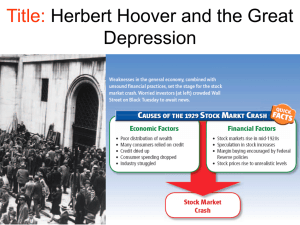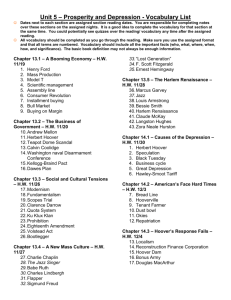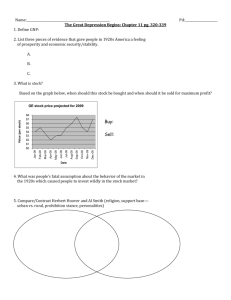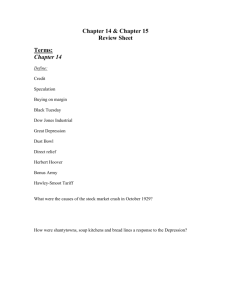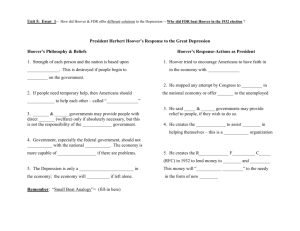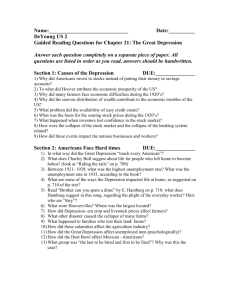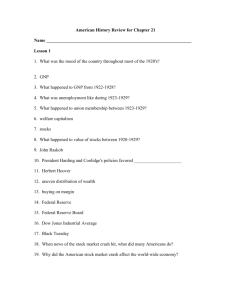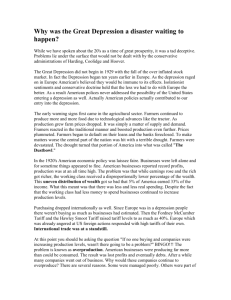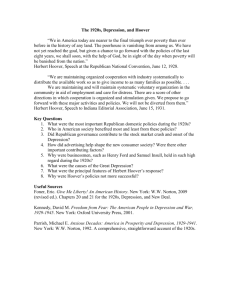Hoover Struggles with the Depression
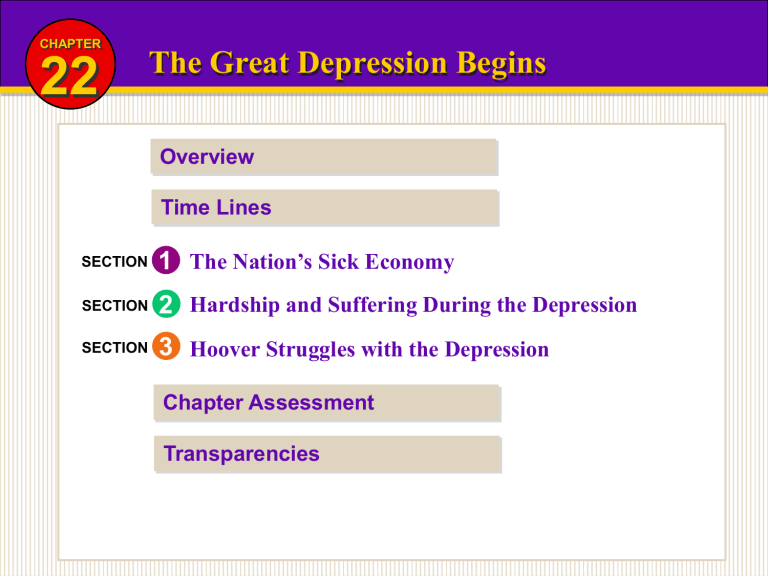
CHAPTER
22
The Great Depression Begins
Overview
2 Hardship and Suffering During the Depression
3 Hoover Struggles with the Depression
Transparencies
CHAPTER
22
The Great Depression Begins
“The illusory prosperity and feverish optimism which marked preceding years have given way to fearful economic insecurity and to widespread despair.”
Senator Robert M. La Follette, Jr., 1931
HOME
THEMES IN CHAPTER 22
Economic Opportunity
Immigration and Migration
The American Dream
CHAPTER
22
The Great Depression Begins
“The illusory prosperity and feverish optimism which marked preceding years have given way to fearful economic insecurity and to widespread despair.”
Senator Robert M. La Follette, Jr., 1931
HOME
What do you know?
• What do you already know about the Great
Depression?
• Have you ever discussed the Depression with a
relative who lived through it?
If so, what did he or she say?
Read the quote above and answer the following:
• What does La Follette suggest about the
prosperity and optimism of the years
preceding the Depression?
CHAPTER
22
Time Line
The United States
October 1929 The stock market crashes.
June 1930 The Hawley-Smoot Tariff Act
becomes law.
July 1930 Congress creates the Veterans
Administration.
1931 Hoover proposes a one-year delay in
repayment of war debts and reparations.
Between 4 million and 5 million Americans
are unemployed.
1932 The Reconstruction Finance Corporation is
established.
1933 More than 13 million Americans are
unemployed.
Average annual income drops to $1,500 per
family.
HOME
CHAPTER
22
Time Line
The World
1930 Army officers led by José Uriburu seize
control of the government in Argentina.
1931 Austria suffers economic collapse.
September 1931 Japan occupies Manchuria.
1932 Ibn Saud becomes king of Saudi Arabia.
September 1932 From prison, Mohandas K.
Gandhi leads a protest against British
policies in India.
1933 Adolf Hitler comes to power.
Japan withdraws from the League of Nations.
HOME
SECTION
1 The Nation’s Sick Economy
Learn About economic problems affecting industries, farmers, and consumers at home and abroad.
HOME
To Understand the causes of the Great Depression.
SECTION
1 The Nation’s Sick Economy
Key Idea
Economic problems affecting industries, farmers, and consumers lead to the Great
Depression.
HOME
Section 1: The Nation’s Sick Economy
Economic troubles on the Horizon
Industries in trouble
Railroad, Steel, and Textile
Farmers
WWI prices and demand was high world wide
Prices dropped after the war (1919-1921) so farmers boosted production in hopes of selling more crops…just made prices decline more
Farmers defaulted on loans…banks began to fail
Congress tried to help with the McNary-Haugen bill
Price-Supports: government would buy surplus crops at guaranteed prices and sell them on the world market
President Coolidge vetoed the bill twice
Economic Troubles on the Horizon cont…
Consumers have less money to spend
Farmers bought fewer goods
Rising Prices, stagnant wages, unbalanced distribution of income, and overbuying on credit in previous years
Living on Credit
Credit: an arrangement in which consumers agreed to buy now and pay later for purchases…usually in installment plans
Uneven Distribution of Income: rich get richer
Between 1920 and 1929 the income of the wealthiest
1% rose by 75% compared with a 9% increase for
Americans as a whole
70% of the families earned less than $2,500
Hoover Takes the Nation
1928 Election: Herbert Hoover Republican vs
Alfred E. Smith Democrat
Hoover had little political experience while Smith had been the Governor of New York for four terms
Hoover’s main advantage was he was Republican and people believed in the Republican party b/c of the successful past 8 years…Hoover won big
The Stock Market
Dow Jones Industrial Average
The most widely used barometer of the stock market’s health
The Dow is measured based on the stock prices of 30 representative large firms trading on the New York Stock
Exchange
Speculation: buying stocks and bonds on the chance of a quick profit, while ignoring the risks
Buying on Margin: paying a small percentage of a stock’s price as a down payment and borrowing the rest
Stock goes down and the buyer has no way to repay his debt
The Unrestricting buying and selling fueled the market’s crash
The Stock Market Crash
Black Tuesday
October 29, 1929
Shareholders frantically tried to sell their stock
Number of shares sold that day reached 16.4 million
Additional millions of shares could not find buyers…people who had bought stock on credit were stuck with huge debts
Financial Collapse
Great Depression: the period from 1929-1940 in which the economy plummeted and unemployment skyrocketed
The Stock Market crash alone did not cause the Great Depression but it did signify the collapse of the economy and made the depression even more severe
Banks Fail
Many people withdrew their money from banks after the crash but some couldn’t get their money b/c banks had invested their money in the stock market
The government did not protect or insure bank accounts
In 1929, 600 banks closed…By 1933, 11,000 of the nations
25,000 banks had failed
Business Failures
Between 19291932 the Gross National Product (the nation’s total output of goods and services) was cut nearly in half from 104 billion to 59 billion
Unemployment went from 3% in 1929 to 25% in 1933
Worldwide Shock Waves
The Great Depression affected the world economy
World trade dropped
Hawley-Smoot Tariff: Passed by Congress in 1933 which established the highest protective tariff in US history
Designed to help protect American farmers and manufacturers from foreign competition
Opposite effect…reduced the flow of goods into the US, prevented other countries from earning American currency to buy American goods, made unemployment worse in industries that could no longer export goods to Europe, many countries retaliated by raising their own tariffs
World Trade had fallen more than 40%
Causes of the Great Depression
1. Tariffs and war debt policies that cut down the foreign market for American goods
2. A crisis in the farm sector
3. The availability of easy credit
4. An unequal distribution of income
http://www.firstladies.org/curriculum/curriculum.asp
x?Curriculum=1829
SECTION
1 The Nation’s Sick Economy
HOME
Section 1 Assessment
SUMMARIZING
What were some of the causes and effects of the 1929 stock market crash? speculation buying on margin falling stock prices loss of confidence loss of savings
Stock Market
Crash bank failures bankrupt businesses high unemployment worldwide depression
SECTION
1 The Nation’s Sick Economy
Section 1 Assessment
ANALYZING CAUSES
How did the economic trends of the 1920s help cause the
Great Depression?
HOME
THINK ABOUT
• what happened in industry
• what happened in agriculture
• what happened with consumers
SECTION
1 The Nation’s Sick Economy
Section 1 Assessment
DRAWING CONCLUSIONS
Judging from the events of the late 1920s and early 1930s, how important do you think public confidence is to the health of the economy?
THINK ABOUT
• what happened when overconfidence in the stock market
led people to speculate and buy on margin
• what happened when lack of confidence caused people to
sell stocks and close out bank accounts
HOME
SECTION
2 Hardship and Suffering During the Depression
Learn About living conditions during the Great Depression.
HOME
To Understand how people coped with hard times.
SECTION
2 Hardship and Suffering During the Depression
HOME
Key Idea
The Great Depression brings suffering of many kinds and degrees to people from all walks of life.
Section 2: Hardship and Suffering During the Depression
The Depression Devastates People’s Lives
Depression in the cities
Shantytowns: little towns consisting of shacks
Soup kitchens: offering free or low-cost food
Bread lines: lines of people waiting to receive food provided by charitable organizations or public agencies
Depression affects minorities
African Americans and Latinos suffered from unemployment, low pay, and racial violence
The Depression in Rural Areas
Between 1929 and 1932, 400,000 farms were lost through foreclosure: the process by which a mortgage holder takes back property if an occupant has not made payments
The Dust Bowl: the region (including Texas, Oklahoma, Kansas,
Colorado, New Mexico, and the Dakotas) that was made worthless for farming by drought and dust storms during the 1930’s
Previous farming had exhausted the land through overproduction of crops
Plowing had removed the thick protective layer of prairie grasses
When the drought and winds began little grass and few trees were left to hold the soil down
Okies: a negative term used for people who migrated
Most migrated West along Route 66 to California
Effects on the American Family
Some families broke apart
Others were able to make ends meet
Many men left their homes and wandered the countryside
Hoboes: men who wandered the country hitching rides on railroad boxcars and sleeping under bridges
Left b/c they were disheartened by their inability to support their families and so abandoned them…others hoped to find work and send money home to their families
Direct Relieve: cash payments or food provided by the government to the poor
Effects on the American Family cont…
Women struggle to survive
Hard to keep jobs…men resented them
Very good at saving
Often times more reluctant than men to take a handout
Children suffer hardships
Many suffered from poor diets and inadequate health care
Rickets: caused by a vitamin D deficiency and results in defective bone growth
Many child welfare programs and even schools were shut down
“Hoover tourists”: teenage boys and some girls hopped aboard
America’s freight trains to zigzag the country in search of work, adventure and an escape from poverty
Very dangerous…From 1929-1939 24,000 trespassers were killed
Social and Psychological Effects
Between 1928 and 1932 the suicide rate rose more than 30%
3x as many people were admitted to state mental hospitals
Adults stopped going to the doctor or dentist
Young people gave up dreams of college, put off getting married, had smaller families
Fears of broken life and ill health were handed down from parents to children
Many peoples primary concern for the rest of their lives was to never be broke again
Great Depression also showed a generation who banded together with millions of acts of kindness
Families helped other families and strangers as they shared their resources and strengthened the bonds within their communities
SECTION
2 Hardship and Suffering During the Depression
HOME
Section 2 Assessment
SUMMARIZING
What groups of people were affected by the Great Depression?
How were they affected?
GROUP urban poor
EFFECTS OF DEPRESSION lived in shantytowns, ate in soup kitchens or bread lines
African Americans experienced increased discrimination
Latino Americans farmers unemployed men experienced increased discrimination lost land and headed west wandered country looking for work
SECTION
2 Hardship and Suffering During the Depression
HOME
Section 2 Assessment
COMPARING AND CONTRASTING
Compare what happened to city dwellers and to farmers during the Great Depression. How was it similar and different?
THINK ABOUT
• what happened to their livelihoods
• what happened to their homes
• what help was available to them
SECTION
2 Hardship and Suffering During the Depression
HOME
Section 2 Assessment
RECOGNZING EFFECTS
How did the Dust Bowl affect the entire country?
THINK ABOUT
• the effect on farmers on the plains
• the effect on California and other states where the Okies
resettled
• the effect on the East
SECTION
3 Hoover Struggles with the Depression
Learn About
President Hoover’s response to the Great Depression.
HOME
To Understand why the Hoover administration lost public support.
SECTION
3 Hoover Struggles with the Depression
Key Idea
President Hoover tries to restore confidence and halt the Depression, but his actions are ineffective.
HOME
Section 3: Hoover Struggles with the
Depression
Herbert Hoover: elected President in 1928
Hoover Tried to Reassure the Nation that the economy was on a sound footing
He believed that Government should play a limited role in helping to solve problems
Hoover believed that reason could solve all problems…even economic issues
Government should foster cooperation between competing groups and interests in society…(middle man)
American’s valued rugged individualism
Hoover did not support any form of federal welfare
Believed it would weaken people’s self-respect
Hoover believed that individuals, charities, and local organizations should pitch in to help care for the less fortunate
Boulder Dam
Before President Hoover served as Secretary of
Commerce…proposed the construction of the Boulder
Dam
Would be the world’s tallest dam and the second largest
Built on the Colorado River
$700 million public works program that would pay for itself from the profits of sales of the electric power that the dam would generate
The dam provides electricity, helps with flood control, and provides a regular water supply
Enabled the growth of California’s massive agricultural economy
Provides water for cities such as Los Angeles and Las Vegas
Construction started in 1929 while Hoover was in office
http://www.history.com/photos/new-dealprograms/photo12
American’s Blame Hoover
In 1930 Republicans loss Congress
Farmers burned their corn and wheat and dumped their milk on highways rather than sell it at a loss
Famers declared a “farm holiday” and refused to work their fields…others blocked roads to prevent food from getting to the market hoping that food shortages would raise prices
Shantytowns became known as “Hoovervilles” homeless wrapped themselves in newspapers known as “Hoover blankets”, empty pockets turned inside out were “Hoover flags”
People blamed Hoover because he was the leader and they were looking for results…Hoover was not producing results
Hoover Takes Action
Hoover finally softened his position on government intervention in the economy and takes a more active approach
Still only believes in small government
Federal Farm Board: intended to raise crop prices by helping members to buy crops and keep them off the market temporarily until prices rose
National Credit Corporation: large banks loaned money to smaller banks, which helped them stave off bankruptcy
Hoover Finally Takes Direct Action
In 1931 Hoover appeals to Congress…Presidential election is looming and Hoover knows he has to act drastically
Federal Home Loan Bank Act: lowered mortgage rates for homeowners and allowed farmers to refinance their farm loans and avoid foreclosure
Reconstruction Financial Corporation: authorized up to $2 billion for emergency financing for banks, life insurance companies, railroads, and other large businesses
Hoover believed that the money would trickle down to the average citizen through job growth an higher wages
Americans did not want to wait…this was too little to late in their eyes
Gassing the Bonus Army
Patman Bill: authorized the government to pay a bonus to
World War I veterans who had not been compensated adequately for their wartime service
Supposed to be paid out in 1945 in the form of cash and a life insurance policy
Congressman Wright Patman believed that the money of $500 per soldier should be paid out immediately
Senate votes down the bill
Marchers and protesters still camped outside of white house…Hoover decides to disband the Bonus Army: WWI veterans trying to get their bonus money
Hoover has General Douglas MacArthur and Major Dwight
Eisenhower carry out the operation
Gassed more than 1,000 people…killing an 11 month old babe, blinding an 8 year old boy, two people were shot
Hoover’s imaged suffered once again…Franklin Delano
Roosevelt benefits from Hoover’s bad decisions
SECTION
3 Hoover Struggles with the Depression
HOME
Section 3 Assessment
SUMMARIZING
What did President Hoover say and do in response to the
Depression?
“rugged individualism” “Any lack of confidence in the economic future . . . is foolish.” public-works programs
HOOVER’S RESPONSES
Boulder Dam sending of troops against Bonus Army
Federal Farm Board
Reconstruction Finance
Corporation
Federal Home Loan Bank Act
SECTION
3 Hoover Struggles with the Depression
Section 3 Assessment
3
ANALYZING ISSUES
How did Hoover’s belief in “rugged individualism” shape his policies during the Depression?
HOME
THINK ABOUT
• what that belief implies about government action
• Hoover’s policies
• whether those policies were consistent with his beliefs
SECTION
3 Hoover Struggles with the Depression
Section 3 Assessment
CLARIFYING
When Franklin Delano Roosevelt heard about the attack on the Bonus Army, why was he so certain that Hoover was going to lose?
THINK ABOUT
• the American public’s impression of Hoover
• Hoover’s actions to fight the Depression
• how people judged Hoover after the attack
HOME
Chapter
22
Assessment
1. How did what happened to farmers during the 1920s
foreshadow events of the Great Depression?
2. Why was uneven distribution of income bad for the
economy?
3. What were some of the effects of the stock market crash
in October 1929?
4. What effect did the Hawley-Smoot Tariff Act have on
the economy and why?
5. How were shantytowns, soup kitchens, and bread lines
a response to the Depression?
HOME
Chapter
22
Assessment
6. Why did minorities often experience an increase in
discrimination during the Great Depression?
7. What pressures did the American family experience
during the Depression?
8. Why did Secretary of the Treasury Andrew Mellon
believe that the government should do nothing about
the Depression?
9. How did Hoover’s treatment of the Bonus Army affect
his standing with the public?
10. In what ways did Hoover try to use the government to
relieve the Depression?
HOME
